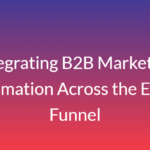Why Funnel-Wide Integration Is Critical in 2025
Today’s B2B buyer journey is no longer linear. Prospects jump between channels, revisit content, and engage at unpredictable intervals. In 2025, marketing teams must deliver consistent experiences across all funnel stages to capture and convert attention.B2B Marketing Automation enables this by creating seamless engagement from top-of-funnel awareness to bottom-of-funnel decision-making without missing a beat.
Top-of-Funnel (TOFU): Capturing Interest at Scale
At the awareness stage, the goal is to attract attention and build brand recognition. B2B Marketing Automation helps distribute blog posts, social content, whitepapers, and ads to segmented audiences. It tracks engagement metrics—such as page visits, content downloads, and clicks—and uses this data to score and qualify leads. Automation platforms also auto-tag leads based on behavior, creating clean segments for future targeting without manual sorting.
Middle-of-Funnel (MOFU): Educating and Nurturing Leads
Once leads are in the system, nurturing becomes the focus. B2B Marketing Automation delivers targeted email workflows, webinar invites, and product-centric content based on the lead’s industry, company size, or behavior. Dynamic content ensures that each lead receives material relevant to their interests and challenges. This continuous education builds trust, establishes authority, and helps move leads closer to a purchase decision.
Bottom-of-Funnel (BOFU): Driving Conversion with Precision
When leads approach the decision stage, automation becomes even more critical. B2B Marketing Automation systems notify sales reps in real-time when a lead visits the pricing page or submits a contact form. Automated sequences send personalized offers, demo requests, and comparison guides. All communication is timely, relevant, and designed to reduce friction at the final stage of the funnel.
Re-Engaging Cold Leads and Funnel Recycling
Not all leads move quickly. Some stall mid-funnel or lose interest after initial engagement. B2B Marketing Automation allows marketers to set up re-engagement workflows to recycle these leads effectively. These sequences might include refreshed content, updated offers, or survey requests to understand buyer hesitation. Funnel recycling keeps your database active and ensures valuable leads aren’t lost due to inactivity.
Funnel Analytics and Attribution Tracking
Full-funnel automation also delivers rich analytics. Marketers can see where leads enter the funnel, where they drop off, and which touchpoints lead to conversion. B2B Marketing Automation platforms use multi-touch attribution models to assign value to every action, giving teams deep visibility into which campaigns, channels, and content contribute to growth. This level of insight supports better decision-making and smarter spend.
Unified Data for Seamless Transitions Between Stages
A major strength of B2B Marketing Automation is centralized data. Whether a lead comes in via social media, organic search, or a referral link, their journey is logged from day one. As the lead progresses, every touchpoint, score update, and sales interaction is documented. This continuity ensures no context is lost as leads move from marketing to sales and eventually to customer success.
Adaptive Content Based on Funnel Position
Smart content delivery is key to funnel efficiency. B2B Marketing Automation platforms allow for adaptive content blocks in emails, landing pages, and websites. A lead in the early awareness stage might see blog highlights, while a returning visitor with high engagement could see a direct CTA to request a quote. Content personalization by funnel stage increases relevance and boosts conversions without increasing manual effort.
Campaign Orchestration for Funnel Alignment
Integrated campaign orchestration ensures that efforts across email, social, PPC, and events work together. B2B Marketing Automation helps marketers build unified campaigns with consistent messaging and timing across channels. As prospects respond, their funnel position updates automatically, ensuring they always receive the right message based on their current stage. This orchestration creates a coherent brand experience that builds confidence and encourages action.
Automating Internal Collaboration Across Funnel Teams
Successful full-funnel engagement requires tight collaboration between teams. B2B Marketing Automation fosters this by automating internal workflows—like notifying BDRs when a lead reaches MQL status, assigning follow-ups, or triggering Slack messages for high-intent behaviors. These automated workflows keep marketing, sales, and customer success aligned and responsive at every stage of the buyer journey.
Read the Full Blog Now @ https://acceligize.com/featured-blogs/what-is-b2b-marketing-automation-and-why-it-matters-in-2025/
About Us
Acceligize is a global leader in B2B demand generation, helping brands transform their marketing through data-driven insights, next-gen automation, and innovative strategies. With a presence across North America, EMEA, and APAC, Acceligize partners with leading organizations to accelerate revenue through qualified leads and marketing intelligence. Our solutions leverage the latest in AI and automation to ensure clients stay ahead of industry trends and connect with their ideal audiences.

